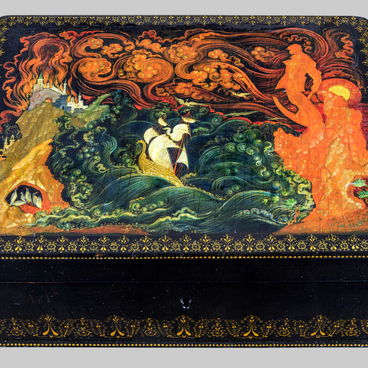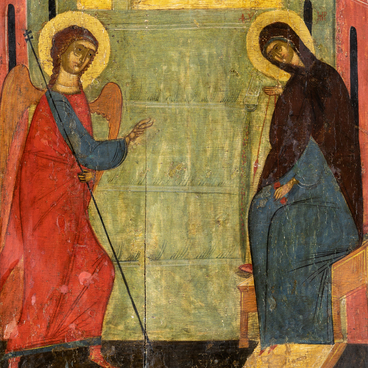The icon of Theotokos of Bogolyubovo was created in the second quarter of the 19th century. During that period, the style of the Palekh icons underwent some changes. The faces of the saints became more alike and not so expressive. The softness of features that had existed before disappeared. The contrast of light and shadow became stronger as the artists started making the images brighter. The color palette of the icons had also become brighter by the 19th century and was enriched with new shades.
This changes were inspired by the Empire style, which became popular in Russia in the 19th century. Empire is also called the imperial style and is considered the pinnacle of classicism. It originated in France during Napoleon’s reign, and its main task was to glorify the imperial authority. The Empire art is notable for its monumentality and grandeur, with human figures often resembling the classical ancient statues.
The icon of Theotokos of Bogolyubovo is considered one of the prime examples of the influence of the Empire style on Russian painting traditions. Classicism can be seen in the sculptural shape of figures, ornamental decorations, and the attention to details. The artist put a lot of effort into the architectural decor, down to every single brick. The use of golden ornaments on cinnabar bevels was another distinctive feature of that time. Thanks to it, we can conclude that the icon was created in the 1820s–1830s.
The author’s painting of the Theotokos of Bogolyubovo was inspired by an ancient wonderworking icon. This is evident from the inscription in the red square to the left of the Theotokos. In the upper right corner, the artist depicted Jesus in the clouds: the Savior’s fingers are folded in a two-finger blessing gesture. On top of the centerpiece, there is a half-length Deesis, an icon with the Theotokos and St. John the Baptist in prayer poses on either side of Christ. The Deesis icons also often contain images of angels, apostles, and great martyrs.
Full-length figures of saints can be seen to the right and left of the centerpiece. On the left, from top to bottom, we see the images of John the Faster, the Patriarch of Constantinople; John the Baptist with a severed head in his hands; and the Holy Martyr Tatiana. On the right, from top to bottom, we see the Holy Hieromartyr Timothy, Bishop of Prusa; Irene the Great Martyr; and the Holy Monastic Martyr Eudokia.
The author boldly improvised with color. The rich palette is full of pink-lilac, turquoise, and blue shades. The author also depicted a dandelion meadow, unusual for a traditional icon. The layers of the earth are painted in loose strokes, as are the multicolored swirling clouds formed by subtle nuances of color. However, despite the many novel techniques, the artist did not deviate too far from traditions: for example, the landscape with hills, bushes, and grass is a common element of the Palekh icons.
This changes were inspired by the Empire style, which became popular in Russia in the 19th century. Empire is also called the imperial style and is considered the pinnacle of classicism. It originated in France during Napoleon’s reign, and its main task was to glorify the imperial authority. The Empire art is notable for its monumentality and grandeur, with human figures often resembling the classical ancient statues.
The icon of Theotokos of Bogolyubovo is considered one of the prime examples of the influence of the Empire style on Russian painting traditions. Classicism can be seen in the sculptural shape of figures, ornamental decorations, and the attention to details. The artist put a lot of effort into the architectural decor, down to every single brick. The use of golden ornaments on cinnabar bevels was another distinctive feature of that time. Thanks to it, we can conclude that the icon was created in the 1820s–1830s.
The author’s painting of the Theotokos of Bogolyubovo was inspired by an ancient wonderworking icon. This is evident from the inscription in the red square to the left of the Theotokos. In the upper right corner, the artist depicted Jesus in the clouds: the Savior’s fingers are folded in a two-finger blessing gesture. On top of the centerpiece, there is a half-length Deesis, an icon with the Theotokos and St. John the Baptist in prayer poses on either side of Christ. The Deesis icons also often contain images of angels, apostles, and great martyrs.
Full-length figures of saints can be seen to the right and left of the centerpiece. On the left, from top to bottom, we see the images of John the Faster, the Patriarch of Constantinople; John the Baptist with a severed head in his hands; and the Holy Martyr Tatiana. On the right, from top to bottom, we see the Holy Hieromartyr Timothy, Bishop of Prusa; Irene the Great Martyr; and the Holy Monastic Martyr Eudokia.
The author boldly improvised with color. The rich palette is full of pink-lilac, turquoise, and blue shades. The author also depicted a dandelion meadow, unusual for a traditional icon. The layers of the earth are painted in loose strokes, as are the multicolored swirling clouds formed by subtle nuances of color. However, despite the many novel techniques, the artist did not deviate too far from traditions: for example, the landscape with hills, bushes, and grass is a common element of the Palekh icons.




